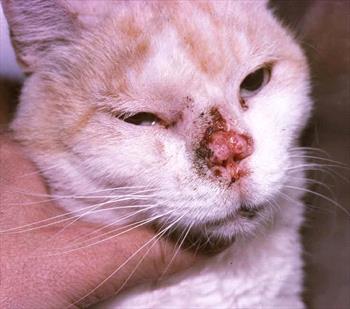neoplasia in cats bladder
A variety of blood tests can help detect and diagnose. At least one clinical sign was noted in 111 of 118 941 of cats and the median duration of clinical signs was 30 days range 0-730 days.

Ataxia In Cats Loss Of Balance In Cats Petmd
Bacterial in 65-75 cases.

. The exact etiology is unknown. Most cats 780. The cat was reported to be incontinent and treatment was declined by the owners.
Buffington C A Chew D J Kendall M S et al 1997 Clinical evaluation of cats with nonobstructive urinary tract diseases. Unusual odor of urine. Neoplasms of the ureters bladder and urethra are uncommon in dogs and rare in cats.
JAVMA 210 1 46-50 PubMed. Symptoms of Bladder Cancer. Ad Enjoy Fast Free Shipping On Orders 49 With 100 Satisfaction Guaranteed.
This is a malignant cancer usually arising from the inside surface of the urinary bladder or urethra and less commonly from the muscular wall of the urinary tract. There are many different forms of cancer and since the symptoms are so varied any lumps or bumps wounds that dont heal changes in behavior including appetite weight litter. Surgical resection by partial segmental resection is the treatment of choice.
Lower Urinary Tract Neoplasia 1. Transitional cell carcinoma TCC is a malignant aggressive and metastasizing spreading cancer arising from the transitional epithelium the highly stretchable lining of the urinary tract system of the kidney ureters the tubes that carry fluid from the kidneys to the bladder urinary bladder. Feline bladder cancer tumors can obstruct your cats urinary tract making the animal unable to urinate.
Müllerian ducts begin as two ducts in the female embryo developing into the vagina uterus. Neoplasms of the canine and feline urinary bladder are diagnostic and therapeutic challenges to the veterinary clinician. Rhabdomyosarcoma is a very rare metastasizing spreading and malignant type of tumor.
Bacteruria pyuria and positive urine cultures are common in cats. The urinary bladder is the most common site of urinary tract neoplasia in dogs and the second most common site of urinary tract neoplasia in cats after renal lymphoma. The typical symptoms of bladder tumors include.
Renal neoplasia is cancer located in the kidney. Transitional Cell Carcinoma of the Lower Urinary Tract in Dogs. The low incidence in cats may be due to a difference in tryptophan metabolism that results in low urinary concentrations of carcinogenic tryptophan metabolites.
Bladder cancer can also spread to other parts of the body. They are more likely to be malignant than benign. There is a higher incidence in humans who work in chemical industries and it is speculated chemicals in flea and tick.
It may derive from stem cells or originate in the striated muscle that surrounds the developing Müllerian or Wolffian ducts. Painful urination and the cat may be very vocal when urinating. A bladder tumor may be located in different areas of the bladder.
A case of feline rectal prolapse which appeared to be secondary to transitional cell carcinoma of the urinary bladder is described. The urinary bladder is the most common site of urinary tract neoplasia in dogs and the second most common site of urinary tract neoplasia in cats after renal lymphoma. Depending on the location of the tumor the cat may or may not present symptoms.
When tumors appear in the urinary tract of cats the cells that line the urinary tract are affected. The urinary bladder is the most common site of lower urinary tract neoplasia in both dogs and cats 1 2. Abnormal swellings that persist or continue to grow Sores that do not heal Weight loss Loss of appetite Bleeding or discharge from any bodily opening Offensive odor Difficulty eating or swallowing Hesitation to exercise or loss of stamina Persistent.
Blood in the urine. When tumors appear in the urinary tract of cats the cells that line the urinary tract are affected. Signs that a cat has liver disease can vary and include loss of appetite vomiting stomach ulceration diarrhea fever blood clotting problems jaundice abdominal swelling excessive urination and thirst changes in liver size weight loss and occasionally gastrointestinal bleeding.
While cancer is usually diagnosed in senior cats certain cancers can develop in cats of any age. Ad Vet Experts Ready To Answer Your Questions. Urinary bladder cancer however easily spreads to other areas of the body and may soon show the following symptoms.
However due to delays in diagnosis. 92 of 118 had previously been presented to a veterinarian for signs of urinary tract disease. Primarily in male cats and are commonly young to middle aged.
Transitional Cell Carcinomas Transitional cell carcinoma TCC is a prevalent type of bladder cancer in cats and more cats get diagnosed with transitional cell carcinoma than other types of bladder cancer every year. Save Up To 35 On All Pet Medication Brands. Tumors location vary greatly inside the bladder.
Chronic urinary tract infection UTI Cystitis. Cats presenting to the veterinarian for the first time with lower-urinary-tract signs that are older than 8 years of age should be evaluated for the presence of urinary-tract infection bladderurethral stones and neoplasia not just assumed to have idiopathic sterile cystitis. Bloody urine Urethral obstruction causing an inability to urinate Pain upon palpation of the back or pelvic regions Weakness Exercise intolerance Polydipsia Polyuria with only a small.
Swalec K M Smeak D D Baker A L 1989 Urethral leiomyoma in a. Most common tumor type. Most renal tumors are seen in middle aged to older dogs and cats.
Your cats prognosis will depend on the size of the tumor whether or not the cancer has spread and the treatment your cat receives. Urinary tract tumors can occur anywhere along the urinary system from the kidneys to the urethra. There are several types of bladder tumours in cats transitional cell carcinoma TCC is the most common other types include benign mesenchymal tumours squamous cell carcinoma rhabdomyosarcoma and lymphoma.
In dogs the most common type of urinary tract tumors are bladder tumors and of these the most common is transitional cell carcinoma TCC. The diagnosis of a urinary bladder neoplasm is generally delayed because of a lack of overt clinical signs or a partial response to empirical treatment. Bladder neoplasia is rare in cats but is more common in cats older than 10 years.
1 2 Transitional cell carcinoma TCC is the most prevalent lower urinary tract cancer in dogs and considerable information regarding TCC is available for dogs including common anatomical. Nephroblastomas rapidly developing malignant tumors are seen in younger animals. Rhabdomyosarcoma of the Urinary Bladder in Cats.
Urinary bladder tumors are rare in cats but of the possible cancers transitional cell carcinoma is the most commonly diagnosed. Very rare. The exact cause of tcc is usually not known but in general canine tcc results from a combination of.
The cause of transitional cell carcinoma is unknown. Epithelial tumors in particular TCC are the most common tumors of the urinary bladder and account for up to 92 of feline bladder tumors Other urinary bladder tumors include SCC ADC rhabdomyosarcoma FSA CSA leiomyosarcoma HSA chemodectoma and benign tumors such as leiomyoma and fibroma. Keep Your Pet Healthy Get Peace Of Mind.
Ad 35 Off Your First Autoship Easy Refills. The remaining 7 of 118 59 of cats had TCC incidentally diagnosed while undergoing. Feline bladder cancer is rare but life-threatening.
In general TCC is an aggressive highly invasive. Symptoms of neoplasia in cats include 4. Hematuria Hematuria stranguria pollakiuria are common presenting signs.
We Offer 247 Live Vet Chat For When You Need It Most. Lymphoma and renal carcinoma are the two most common primary kidney. Renal neoplasia can originate in the kidney primary or spread or metastasize to the kidney from another site secondary.
Euthanasia was performed and necropsy revealed an extensive nodular thickening of the entire urinary bladder wall. Cancer also called neoplasia presents in many different often nonspecific ways in cats. The occurrence of bladder cancer is more common in female cats.
Transitional Cell Carcinoma of the Renal Bladder and Urethra in Cats.

Pin On Keeping Your Dog Healthy

Signs Of Cancer In Cats How To Tell If Your Cat Has Cancer Daily Paws

Nasal Squamous Cell Carcinoma In Cats Veterinary Partner Vin

Does Your Pet Have Cancer 10 Signs Of Cancer In Cats And Dogs Southern Crossing Animal Hospital

Urinary Tract Infection In Cats Royal Canin Royal

Diagnosis And Treatment Of Cancer In Cats

Feline Lower Urinary Tract Disease Flutd International Cat Care

Feline Urologic Syndrome Sandia Animal Clinic
Bladder Cancer In Cats Innovet Pet

Iris Melanosis In Cats Bluepearl Pet Hospital

Urinary Bladder Cancer In Cats Symptoms Causes Diagnosis Treatment Recovery Management Cost

Hair Loss Related To Cancer In Cats Petmd

Feline Kidney Anatomy Vet Tech Student Veterinary Tech Dog Anatomy

Transitional Cell Carcinoma Lap Of Love

Mammary Carcinoma In Cats Bluepearl Pet Hospital
/GettyImages-1311907336-115d94511a7b4120b85edad67c5db9fd.jpg)
How To Treat Skin Cancer In Cats

Cat Can T Pee Signs He May Have A Urinary Blockage Daily Paws

Bladder Tumors In Cats Symptoms And Treatment Options Firstvet
